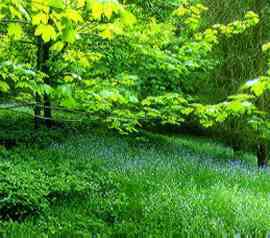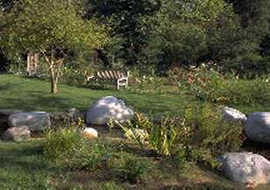Garden Habitats
Some gardens look very neat and tidy with barely a fallen leaf in sight. A few creatures may venture into such a garden but they probably wouldn’t stay for long. An informal garden with a variety of trees, shrubs, flowers and a corner of dead leaves and nettles will attract far more wildlife.
The best way to encourage wild animals is to provide suitable habitats for them – places where they can feed, rest and produce their young. A garden for wildlife does not mean it has to be a scruffy wilderness. With careful planning a wildlife garden can be as beautiful as any formal one.
For a comprehensive list of garden trees, shrubs and plants and their support for wildlife can be found on What to Plant - our factsheet for schools.
The variety of habitats you can create will, of course, depend on how big your garden is, but each is a valuable habitat in its own right. Here are a few examples:
 Trees - Even a single tree in a garden will be important for wildlife but an even better habitat will be created if trees are grouped. The idea is to try and imitate a natural mature woodland – once the major habitat in Britain – with a difference in the height of the trees to form layers. Many plants and animals are most at home in the dappled shade of the woodland edge.
Trees - Even a single tree in a garden will be important for wildlife but an even better habitat will be created if trees are grouped. The idea is to try and imitate a natural mature woodland – once the major habitat in Britain – with a difference in the height of the trees to form layers. Many plants and animals are most at home in the dappled shade of the woodland edge.
It is very important to choose native trees – ones which originated in our country – as many insects will only feed on these.
Once the trees are established you don’t have to work hard! Leave the grass under the trees uncut; this adds to the lower layers and provides shelter for small creatures. Fallen dead leaves are excellent for mini-beasts and they are full of nutrients which are recycled by nature’s decomposers. These are the bacteria and fungi, which gradually break down the leaves into tiny fragments that eventually form a rich soil. Worms and other mini-beasts also help with this decomposition. The decomposers get their energy by breaking down the materials of which dead plants and animals are made – these remains form the humus content of the soil. This humus is broken down by bacteria in the soil into minerals such as nitrates. These dissolve in water in the soil and plants take them up through their roots. This constant recycling of dead material is a very important process.
Any fallen branches or dead trunks should be left undisturbed, unless they are dangerous. This dead timber is gradually broken down by decomposers and provides homes for a multitude of creatures. It is also a good idea to make a pile of logs in a corner of the garden – an excellent habitat for wildlife.
Tree layer: e.g. oak, silver birch, etc.
Shrub layer: e.g. hawthorn, hazel
Herb layer: e.g. fern, bluebell
Ground layer: e.g. short grass, primrose
Grassland - There are thousands of acres of regularly mown lawns in our gardens and parks. These can be a habitat for a few mini-beasts but if they were managed more thoughtfully, they would attract much more wildlife. Obviously, some area of the grass needs to be kept short to provide a place to sit on sunny days, but other parts could be allowed to grow tall. A patch of rough, uncut grass in a corner will attract several animals, providing them with food and shelter.
You may like to try creating a flowering meadow, full of either spring or summer flowers. It is exciting to try growing wild flowers from seed in pots and transplanting them into your meadow.
Remember that you must never spray grassland with chemicals; there are often used by gardeners to kill weeds ( a weed is just a wild flower growing in the wrong place) and encourage the growth of grass. However, these chemicals may also kill the animals we are trying to attract. Also, do not use fertiliser on meadows since these cause the tougher grasses to grow and the more delicate flowers to disappear. Meadow flowers flourish only in poor soils.
Ponds and marshlands - Water is essential for life so it is obviously important to have some available in your garden for wildlife. A simple dish of water for birds to drink from and bathe in is useful, but if you can create a pond then the amount and variety of wildlife will increase dramatically. Our once common wetlands have been steadily destroyed over the years – ponds and ditches have been filled in, marshes drained and they have all suffered pollution. Over 80 per cent of all ponds are now in private gardens. The common frog would be almost extinct by now if it had not managed to find a refuge in our garden ponds, and many other animals rely on ponds for their survival. Creating a pond in your garden is a sure way of helping wildlife and it is one of the most enjoyable habitats to study.
 A pond should be as large as space allows, but even a small one is better than nothing. There are many useful books and leaflets available to help you make and look after a pond.
A pond should be as large as space allows, but even a small one is better than nothing. There are many useful books and leaflets available to help you make and look after a pond.
Instead of, or as well as a pond, an area of marshy land could be created by sinking a pond liner a few inches down into the soil. Wild marsh-loving plants growing there will attract many species of animals.
 Flower beds - The size of your garden will limit the number and variety of animals living in it, but there are ways to enrich the habitat by adding things to attract passing wildlife. A pond is a good way of attracting visiting birds and mammals, such as hedgehogs, bats and foxes, but planting a flower bed or border is another excellent attraction. Butterflies, other insects and birds will really appreciate the supply of nectar, pollen and seeds.
Flower beds - The size of your garden will limit the number and variety of animals living in it, but there are ways to enrich the habitat by adding things to attract passing wildlife. A pond is a good way of attracting visiting birds and mammals, such as hedgehogs, bats and foxes, but planting a flower bed or border is another excellent attraction. Butterflies, other insects and birds will really appreciate the supply of nectar, pollen and seeds.
Wild flowers grown in colourful groups are a very important source of food but there are several cultivated garden flowers and shrubs, e.g. buddleia, snapdragons, ice plants, marigolds, that are just as good. Choose the varieties carefully so that there are some in bloom throughout the year, ensuring a constant supply of natural food. A beautiful ‘butterfly garden’ is a sight for us to enjoy too!
Remember you will have to grow wild flowers from seed – it is illegal to dig up wild flowers from their natural habitat. You can buy the seeds from garden merchants.
Hedges and walls - A hedge is a row of trees and shrubs, usually used as a boundary or a screen around a field or garden. Even a short hedge is a good wildlife habitat, providing animals with food, shelter and a place to nest. Always choose native plants, e.g. hazel, hawthorn, blackthorn, holly, dog rose. Make it as dense as possible and encourage grasses and wild flowers to grow at the base – this allows animals to hide in the lower layer, sheltered beneath the upper layers of the hedge.
A wall is another type of barrier often found in the garden. It can be quite a good wildlife habitat if creeping plants, such as ivy and virginia creeper, are planted at the base. These will quickly spread, attracting some animals. Cracks and crevices in between the stones or bricks will soon be colonised by algae, mosses, lichens and ferns.
Waste ground and compost heaps - What may be seen as ‘waste’ ground to us can actually be a useful nature reserve for wildlife. Try to keep one corner of your garden undisturbed and see what animals turn up there! Dead leaves, logs, stones, wild flowers (‘weeds’), including nettles, will all be used by something. Remember that waste does not mean a rubbish tip! Remove any litter that may accumulate there.
A compost heap in a garden is not only an excellent way of recycling organic waste, e.g. kitchen vegetable waste, grass cuttings, unwanted weeds etc, but the compost can be used to enrich the soil and the heap itself acts as an attractive habitat to some creatures. Using natural compost to put goodness back into the soil is a much better way of improving a soil than using chemical fertilisers. These can be harmful to wildlife and if they are used continually, eventually the quality of the soil becomes very poor.
The animals found in your garden are not always found in just one habitat; the animals often pass between several habitats. For example, a newt begins its life in the pond and then it leaves the water, crawling through sheltering plants and tall grass, finally finding a cool, damp spot beneath a rotting log to spend the winter. Therefore, it is important to provide a variety of habitats for your garden residents.
